The need to install a ventilation system extends not only to the rooms in which residents spend most of their time - bedrooms, living rooms, kitchens - but also to non-residential premises. Ventilation is especially necessary if heating equipment is installed in utility rooms and boiler rooms.
Both for the safe life of people and for the trouble-free operation of the heat-generating unit, a well-organized air exchange system is required. You will learn everything about how ventilation for a gas boiler in a private house should be arranged from the article we have presented.
We will show you what you need to consider at the preliminary stage. We will explain what should be done before installing the ventilation ducts, what rules to follow during the installation of the system. This information can be useful if you want to do some of the work yourself, without the involvement of specialists.
The content of the article:
- What is ventilation for?
- Installation requirements: all by the law
-
About the types of ventilation in a private house
- Option # 1 - natural system
- Option # 2 - forced system
- Coaxial chimney as a ventilation element
- Conclusions and useful video on the topic
What is ventilation for?
Some owners of cottages and country houses doubt the need for ventilation or argue that an open window in the boiler room is enough to ensure air exchange.
However, it is impossible to keep the window open all the time. Often, a mechanized exhaust is needed for a full-fledged removal of exhaust air, therefore, in addition to natural ventilation, it is necessary to install forced ventilation.
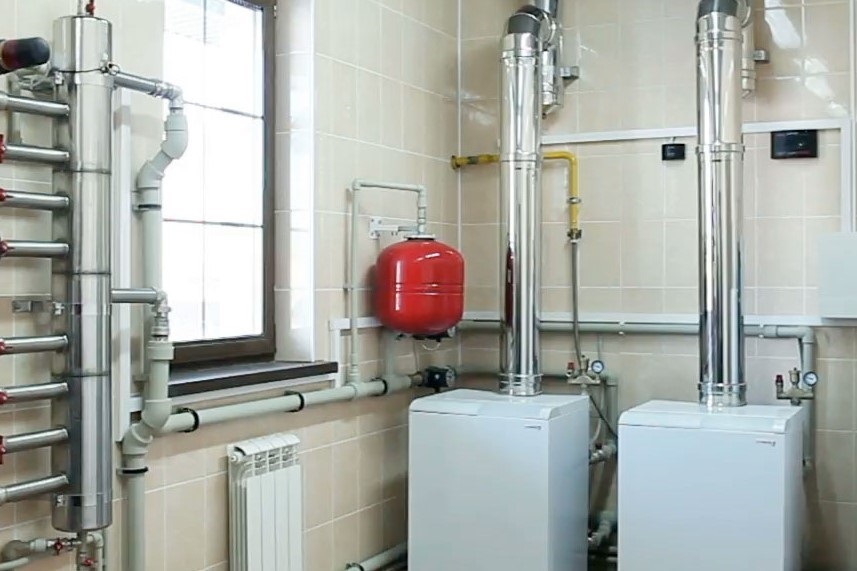
A corridor, an entrance hall, a kitchen are suitable for installing a gas boiler (according to the new rules in the bathroom - not), but the best and safest place is considered a separate boiler room with an established system ventilation
The gas evacuation system performs very important functions:
- Provides oxygen in the amount necessary to ensure the combustion of the fuel. As you know, oxygen deficiency is fraught with consequences such as a decrease in heat transfer, incomplete combustion or an increase in the amount of fuel required, premature wear of equipment, clogging of the chimney with burning and soot.
- Removes combustion products. Part of carbon monoxide can penetrate into the room even with proper installation and operation of the chimney, and its critical concentration in the air is a direct threat to the health of people living in the house.
- Discharges gas if accidentally released into the air. The possibility of leakage of gas lines should also not be overlooked - rarely, but propane leaks do occur. The result can be either the poisoning of the residents, or a powerful explosion.
Only a well-thought-out ventilation system designed in accordance with SNiP requirements when installing a gas boiler can protect against negative consequences. Thanks to supply and exhaust ventilation you protect your family from explosion, fire and poisoning, reduce the load on the boiler, reduce fuel consumption and increase the heat transfer of heating equipment.
Installation requirements: all by the law
At installation of gas boilers, which have become popular due to inexpensive fuel, the requirements are imposed both on the boiler house itself, if the unit is located in a separate non-residential premises, and for the selection of places for all elements of the ventilation systems.
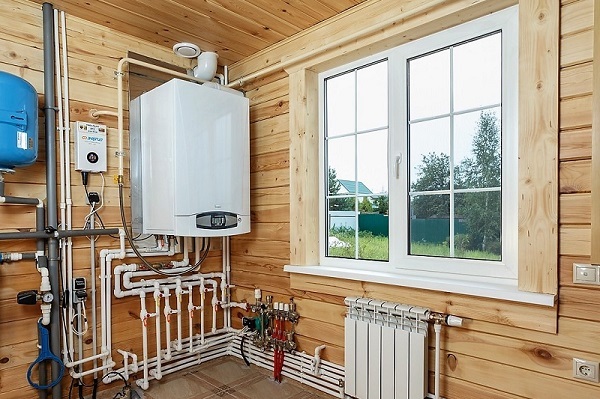
If a household gas boiler has a capacity of more than 30 kW, it must be installed in a separate room. It can be located both in a residential building and outside it.
For units with a capacity exceeding 150 kW, a separate building is erected or an extension to a residential building is made. In the vicinity of the boiler room, through an adjacent wall, there should be a non-residential premises.
The ventilation and air conditioning rules are set out in SNiP 2.04.05-91. The main requirement concerns air exchange, which must be performed in full at least 3 times per hour.
Be prepared for the supervision of representatives of the gas service, who will definitely check:
- the presence of a solid foundation and concrete floor;
- laid communications - water supply, sewerage, heating pipes;
- insulation of walls and gas outlet to prevent freezing during the cold period;
- area - not less than 15 m³;
- ceiling height - 2.2 m and higher;
- compulsory natural lighting - a window of at least 3 cm² for each cubic meter of boiler room volume.
To ensure natural ventilation, the window is equipped with a window, and a small gap is left under the entrance door for free air flow - about 2.5 cm high. Instead of a gap, perforation of the door is used - in the lower part adjacent to the floor or threshold, several holes with a diameter of about 2 cm are made.
If the extension door leads to the house, more precisely, to a non-residential room, then it is made of fire-resistant material with a high fire safety class.
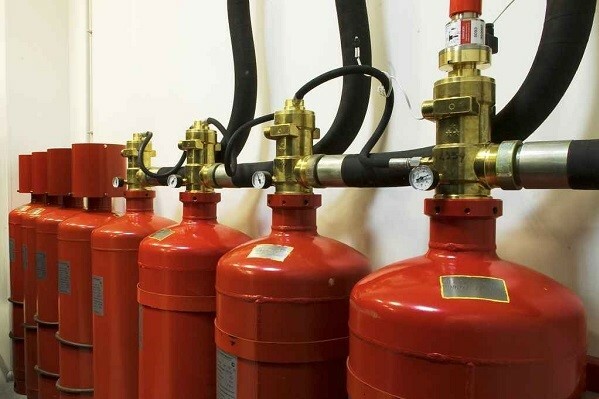
Often, not natural gas is used as fuel, but cylinders with liquefied gas. They cannot be stored next to the boiler.
Another additional room is equipped for the cylinders, and they are connected to the boiler by means of a pipe supplying fuel.
Requirements for chimneys and ventilation:
- gas outlet and air supply are carried out through separate channels;
- the size of the ventilation window for air flow - at least 1/30 of the boiler room area;
- the boiler is installed at a minimum distance from the outlet of the chimney and the ventilation shaft;
- if the coaxial chimney is passed through the wall, then two holes are arranged: the first is directly for the pipe, the second is for maintenance.
Ventilation ducts installed in a private house for floor or wall-mounted gas boiler must always be open so that air circulation is constant.
About the types of ventilation in a private house
The induction of air exchange occurs in two ways: either naturally, or by compulsion.
The natural scheme is used if a boiler with a power of up to 30 kW is used while meeting all the installation requirements set by the manufacturer. The provision of ventilation for the operation of more powerful units is carried out forcibly, using fans. Consider both ventilation methods.
Option # 1 - natural system
Less productive, but simpler natural ventilation is appropriate in small houses with low-power heating equipment. Often it is enough for air exchange processes in basements, attics, sheds and garages.

The air inflow occurs through the vents, ajar windows, openings under the doors, and the exhaust air - through the air ducts installed in the upper part of the walls or in the ceiling and brought out above the roof
Correctly organized ventilation “captures” the entire air volume of the boiler room. To do this, openings for the inlet and outlet of air are arranged at opposite points of the room.
For example, the boiler is installed directly opposite the door, and the exhaust outlet is above the gas equipment. The air moves from below, moves across the room and rises up to the hood. In this case, the window can be located on any wall.
For the supply and exhaust ventilation device in the boiler room of a country house you need to perform a number of actions:
- In the lower part of the door leaf, make several holes with a drill or a small crown. If there is a gap of 2.5 cm or more between the door and the floor / threshold, perforation is not needed.
- Check if there is enough natural light to service the boiler and if the window opens well.
- To ensure a constant flow of air from the street, you can make a hole in the wall with a diameter of 150-200 mm. To do this, use a perforator or drill with a crown-bit of the desired size.
- If a ventilation shaft is provided in the wall, install a decorative grill on the wall and make sure that the pipe brought out to the roof is protected from rain and wind by a cap.
The hole in the wall must also not be left unprotected - debris or rodents can enter the room through it.
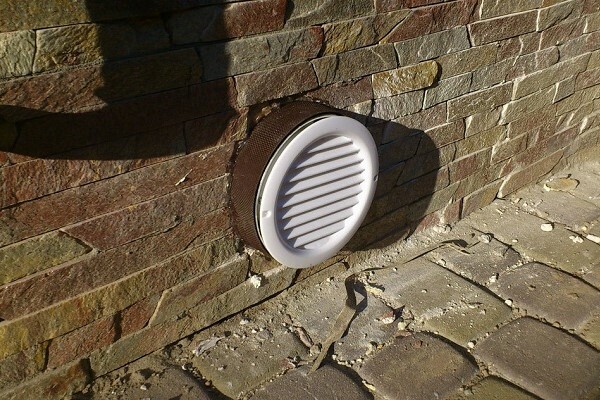
Usually, from the outside, a hole or sleeve inserted into the wall is equipped with a metal grate. Plastic parts are considered unreliable and break quickly
Commercially available supply valves are initially equipped with additional protection means - a grill, mesh or hatch, which is usually kept open.
It is not recommended to install the outlet next to the boiler. In the cold season, a sharp drop in temperature can affect the operation of the boiler, therefore it is better to drill the wall at a distance of at least 1-1.5 m from the installation site of the unit.
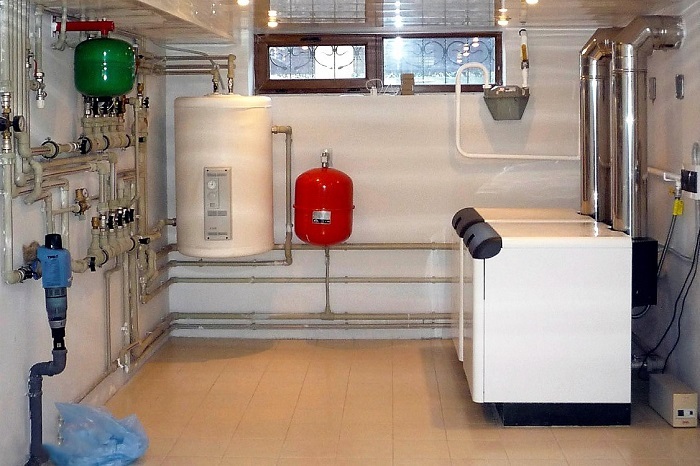
The advantage of natural ventilation, as well as natural lighting, is complete independence from the health of the electrical network. If, for some reason, the electricity in the house is lost, the air exchange in the boiler room will not be disrupted, and there will be enough light to adjust the equipment
If the boiler is installed in a kitchen, the exhaust air duct is led out into the ventilation shaft in the traditional way - through an opening located under the ceiling. Sometimes it's just a pipe leading to the attic and from there to the roof.
System ventilation ducts Is an example of a channel system. Channels can run under false ceilings, in niches and shafts.

If there is no shaft, the pipe is drawn along the walls of the premises and the attic, and then taken out through the roof, making a hole in diameter
In addition to pipes, gates, dampers, connecting elements, decorative grilles, air intakes, aerators are used.
A few tips for installing the duct:
Image gallery
Photo from
A round plastic pipe with a diameter of 20 cm or more can be used as an outflow channel. Smooth inner surface does not impede air movement
A circular saw ensures fast and accurate cutting of plastic. If it is not at hand, you can use a jigsaw.
To ensure a strong connection of the pipe elements at the joints, silicone sealant is used - the edges of the parts are smeared, and the excess is removed
If a plastic ventilation pipe passes through a cold attic, then it must be insulated. In a humid room, sprayed insulation is more suitable than mineral wool
Plastic pipe for air duct
Circular for cutting pipes
Silicone sealant as adhesive
Sprayed insulation for ventilation duct thermal insulation
The advantage of sprayed insulation is the possibility of applying it to already installed pipes. The process is quick and easy, and curved air ducts and pipes located in hard-to-reach places can be thermally insulated.
On the roof, the pipe is brought out to a height of 0.5-1 m above the roofing and covered with a head - a special protective cap.
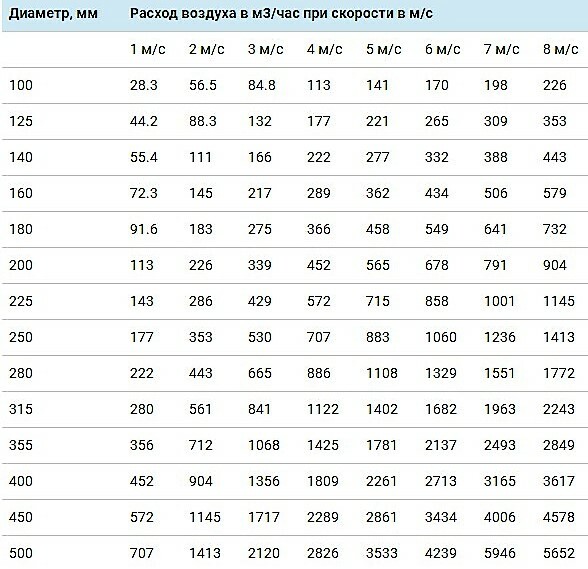
It must be remembered that the diameter of the ventilation ducts for a gas boiler depends on the air exchange rate, the volume of the room and other factors. To avoid complex calculations, you can use ready-made tables
Responsible manufacturers of boiler equipment provide informative instructions for the installation and operation of the units. In the technical documentation, you can find recommendations on the selection of ventilation systems with an indication of the technical characteristics of ventilation ducts.
Option # 2 - forced system
If natural air exchange is not enough to fulfill the manufacturer's recommendations for operating the boiler, then a duct fan must be installed. However, the best solution is a combined system using filters, water heater and fans.
As a result of the operation of the ventilation system, air is forced into the combustion chamber, and the combustion products are removed at the rate required for air exchange.
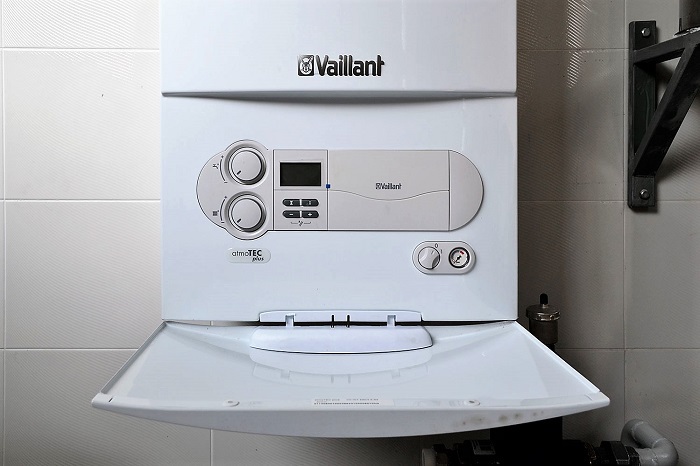
Modern gas boilers for domestic use are equipped with automation that regulates the fuel supply depending on the ambient temperature and other indicators.
Well-tuned ventilation, coupled with controlled equipment, creates a microclimate in which fuel is saved and the efficiency of the entire gas heating system.
To choose the right fan, you need to take into account its performance. Let's assume that the volume of the boiler room is 10 m³. According to the requirements, for 1 hour in the room the air must be changed 3 times, that is, 10 х 3 = 30 m³ / h - the minimum fan performance.
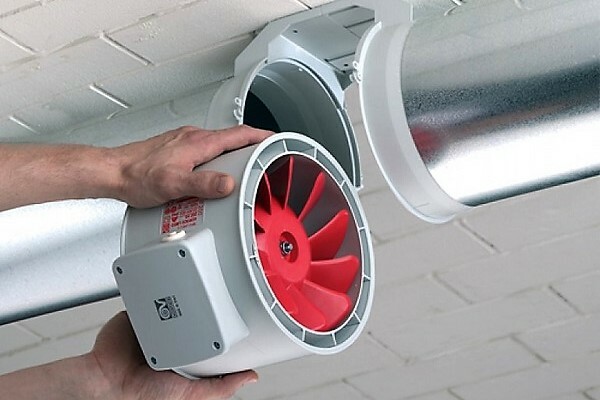
We recommend installing reliable fans in metal or plastic cases in ventilation ducts for gas boilers. They differ in that they do not deform over time and withstand high temperatures.
An automatic regulation can be used, which switches on the ventilation equipment together with the boiler start-up.
Coaxial chimney as a ventilation element
Due to its design coaxial chimneys enjoy a well-founded popularity. They are assembled according to the "pipe-in-pipe" scheme, which allows performing two functions necessary for gas equipment at once: removal of combustion products outside and air supply to ensure the combustion process.
Coaxial chimneys are divided into two types: horizontally and vertically. The first ones are installed in the wall, the second ones are taken out through the ceiling to the attic, then to the roof. The vertical gas discharge system is longer, more expensive, more difficult to install and requires the installation of a condensate trap.
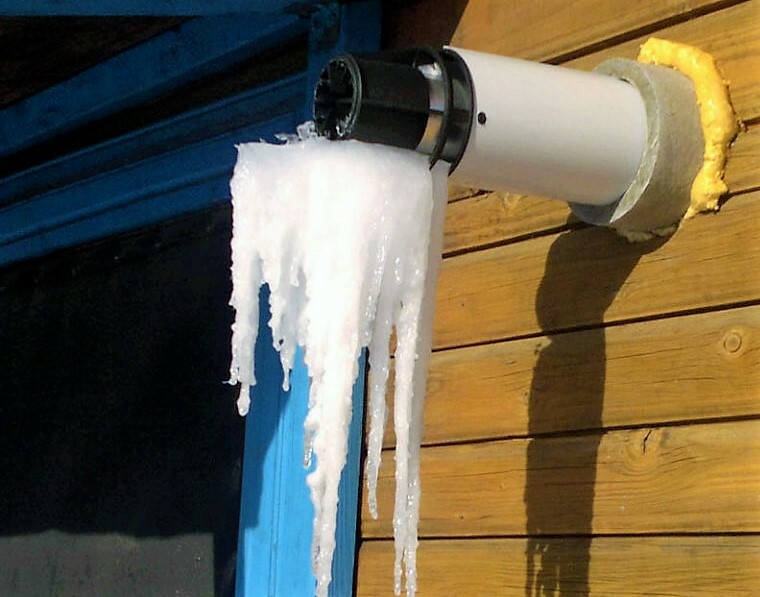
The only drawback of the equipment is the risk of freezing of condensate on the outside, taken out to the outside. The problem is solved by insulating the pipe with mineral wool or other heat-insulating material, although in cold weather this will not save
To combat icing, the end of the pipe is equipped with a lattice head.
Several rules are correct installation of a coaxial chimney:
- It is recommended to equip the outlet of the pipe at a height of 2 m above the ground.
- The distance from the pipe to the window located on top is at least 1 m.
- The condensate collector is not necessary if the pipe is installed at an inclination of 3-12 ° towards the street.
- It is forbidden to bring the highway to an adjacent room.
If there is a gas pipe near the flue outlet, the distance between them must be 0.2 m or more.
The standard equipment of the horizontal equipment consists of a pipe, an elbow for connecting to a boiler, adapters, decorative strips, compression rings, and fastening bolts.
Installation example of a horizontal coaxial chimney that goes out through the wall:
Image gallery
Photo from
To bring the chimney to the street, a sleeve is installed in the wall of the house - a piece of metal pipe secured with foam or sealant
The chimney is inserted into the sleeve so that it faces the street with one end, and the other is located directly above the boiler - for easier connection
A metal ring is inserted into the connecting pipe of the gas boiler to prevent the flame from blowing out. Without a ring, the equipment will give an error
An elastic collar, put on the end of the corner, ensures the tightness of the chimney to the boiler. It closes the joint between the corner piece and the boiler nozzle.
The plastic element performs two functions - decorative and technical. It adheres closely to the wall and ensures the tightness of the connection between the corner piece and the chimney
The corner element is inserted into the coaxial chimney, placed in advance in the sleeve, check the tightness
To secure the cuff, another connecting element is used - a tie. It is made of plastic, and is tightened with two bolts from the kit
The final stage is foaming the sleeve from the outside and installing a decorative silicone cover that covers the exit of the pipe from the wall
Step 1 - sleeve in the wall
Step 2 - installing the chimney into the sleeve
Step 3 - connecting metal ring
Step 4 - corner cuff
Step 5 - plastic element for the chimney
Step 6 - connecting the angle to the chimney
Step 7 - tie on the cuff
Step 8 - decorative element to the outer wall
Measures for the installation of a horizontal coaxial chimney are recognized as the easiest in terms of execution, therefore, they are recommended for self-installation. At the end of the work, the boiler is put into operation and the tightness of the connected pipe is checked.
Conclusions and useful video on the topic
Video # 1. How to provide for all the nuances when installing a boiler room:
Video # 2. More about installing natural ventilation:
Video # 3. Coaxial chimney overview:
The principles of the boiler room ventilation device for gas equipment are similar to equipping other rooms with air ducts, therefore, for experienced craftsmen, most of the work is quite accessible and feasible.
The most difficult stage concerns design and calculations - in order not to make mistakes, we recommend contacting heating engineers or qualified gas installers.
Please leave comments in the block form below, ask questions on points of interest, post photos on the topic of the article. Tell us about how you set up the ventilation system in your own boiler room. Share useful information that will be useful to site visitors.


